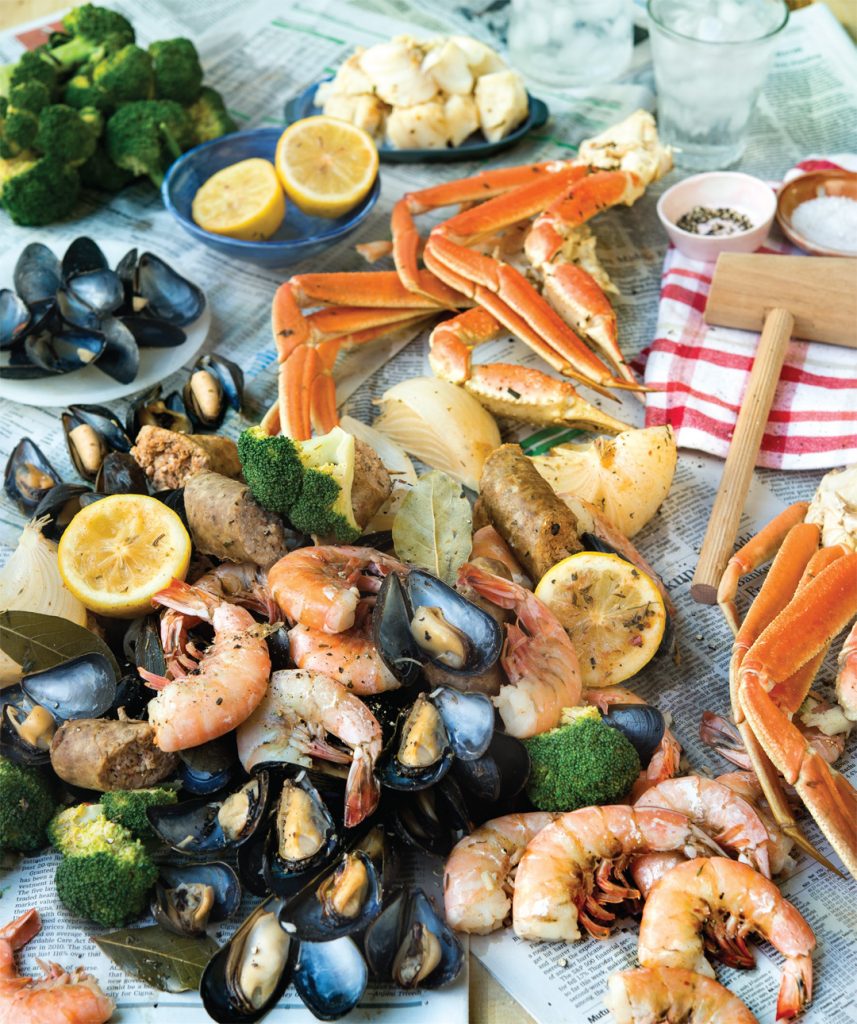 One of my favorite dinners to make in summer is a seafood boil, especially when we have a lot of people over. It does take some time, but it’s always a huge hit and a really fun way to feed a crowd. My brother and I have a recipe we’ve perfected over the years. Usually it includes potatoes and corn, but I omit them here to keep it keto-friendly.
One of my favorite dinners to make in summer is a seafood boil, especially when we have a lot of people over. It does take some time, but it’s always a huge hit and a really fun way to feed a crowd. My brother and I have a recipe we’ve perfected over the years. Usually it includes potatoes and corn, but I omit them here to keep it keto-friendly.
What Are The Health Benefits Of Eating Seafoods?
Although preparing a low-carb seafood boil requires time and a lot of effort, you should be willing to make these sacrifices because this meal actually provides countless health benefits. Seafood is one of the most-loved delicacies that’s packed with several vitamins and minerals.
If you’re planning to use reliable online platforms, such as Legendary Foods Guide, to look for keto-friendly meals that can prevent keto rash, start looking for recipes that use seafood. This ingredient is very keto-friendly and carb-free. There are many keto-friendly recipes that are infused with seafoods today, making it very easy for you to experience variety.
As long as taken in moderate amounts, seafood can provide the following health benefits:
1. Promotes Heart Health
Your heart plays a very significant role in your health and wellness. It’ll be challenging for you to move or even live life comfortably if your heart is unhealthy. Although the human heart naturally weakens with age, eating seafood is a great way to combat these effects.
Seafood is known to promote heart health because it’s packed with omega-3 fatty acids. This nutrient can reduce your risk of cardiovascular diseases, such as stroke and heart attack.
2. Good For Your Joints
Arthritis can take a toll on your health as this can prevent you from moving. Fortunately, you won’t have to worry about the symptoms of this health condition because seafoods are good for your joints. Seafoods can reduce morning stiffness and ease tender joints.
3. Improves Skin Health
You should exert time and effort to take care of your skin as this protects your organs from germs and bacteria. Your skin acts as a barrier that can keep your body healthy, which is why you should make sure that this barrier stays strong.
You can easily achieve this goal by consuming seafoods because this can add moisture to your skin, protect from the sun’s harmful ultraviolet rays, and prevent acne breakouts.
Ingredients
- 4 gallons water
- 6 bay leaves
- 2 onions, quartered
- 2 lemons, halved
- 3 tablespoons salt
- 3½ tablespoons paprika
- 1½ tablespoons ground coriander
- 2 tablespoon ground allspice
- 1 tablespoon red pepper flakes
- 1 tablespoon chili powder
- 1 tablespoon dried marjoram
- 1 tablespoon onion powder
- 1 tablespoon garlic powder
- 1 tablespoon dry mustard
- 1 tablespoon dried tarragon
- 1 tablespoon dried thyme
- 1 tablespoon dried rosemary
- 2½ teaspoons peppercorns
- 1 teaspoon ground cumin
- ½ teaspoon ground cayenne pepper
- 2 pounds Italian sausage, each link cut into thirds
- 1½ pounds mussels
- 2½ pounds cod fillets
- 3½ pounds snow crab legs
- 1½ pounds large raw shrimp, shells on
- Fill a large stockpot over high heat about three-fourths full with the water. Bring to a boil. Add the bay leaves, onions, lemons, salt, paprika, coriander, allspice, red pepper flakes, chili powder, marjoram, onion powder, garlic powder, mustard, tarragon, thyme, rosemary, peppercorns, cumin, and cayenne.
- In a large skillet over medium heat, cook the sausage for about 3 minutes per side, turning to brown all sides. They don’t have to be fully cooked because they’ll finish cooking in the stockpot. Remove from the heat and set aside.
- Remove any excess fat from the skillet and place it back over medium heat. Add the mussels and 1 cup of seasoned water from the stockpot. Cover the skillet and steam the mussels for 5 to 7 minutes. Discard any that don’t open.
- Add the sausage to the stockpot, followed by the cod. Keep the water at a low boil and cook for 5 minutes.
- Add the mussels and crab legs. Cook for 5 minutes more.
- About 5 minutes before you’re ready to serve, add the shrimp. Cook for 4 to 5 minutes until completely pink and opaque.
- Carefully drain the contents of the stockpot and transfer everything to a large serving bowl. Serve immediately. Go traditional and pour the contents of the bowl onto a newspaper-lined table and dig in with your hands!
| Nutrition Facts |
Serving Size 1 |
Nutritional Value Per Serving | Calories 805 kcal Calories from Fat: 360 kcal |
|
% Daily Value*
|
| Total Fat 40 g 114% |
Trans Fat 0.0 g |
carbohydrates 7 g 5% |
Sugars 1 g 1% |
Protein 96 g 192% |
* Above mentioned %DVs (Percent Daily Values) are based on 2,000 calorie food intake.
DVs (Daily values) may be vary depending upon individuals daily calorie needs. Above nutritional values are estimates and should only be used as a guide for approximation. They are not allfoodchef.com recommendations. Calculations are based on average weight of 194 lbs. and ages of 19 to 50 years. |
